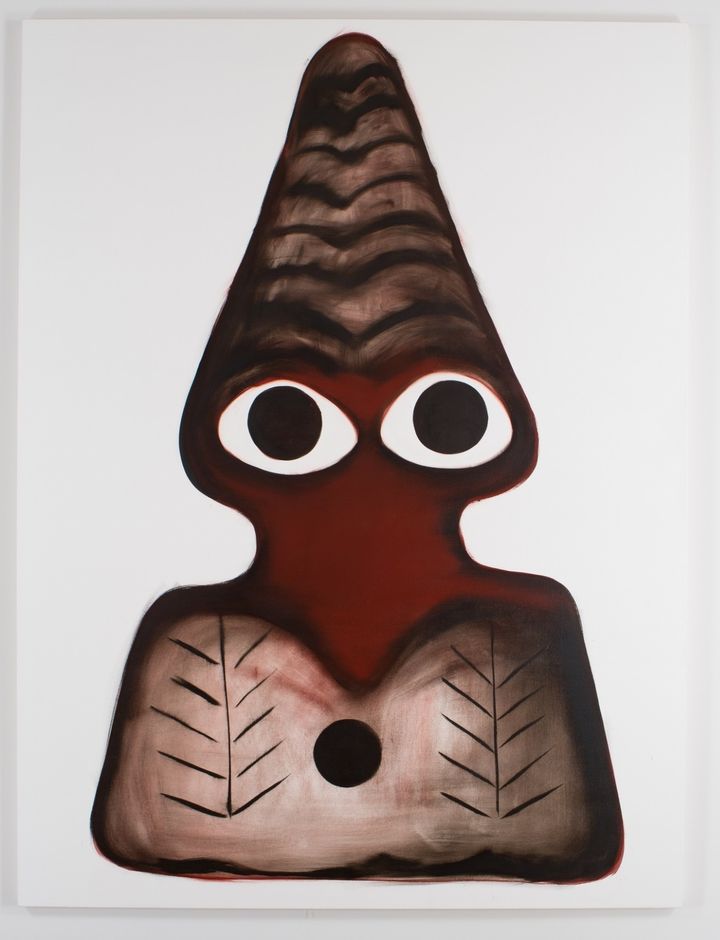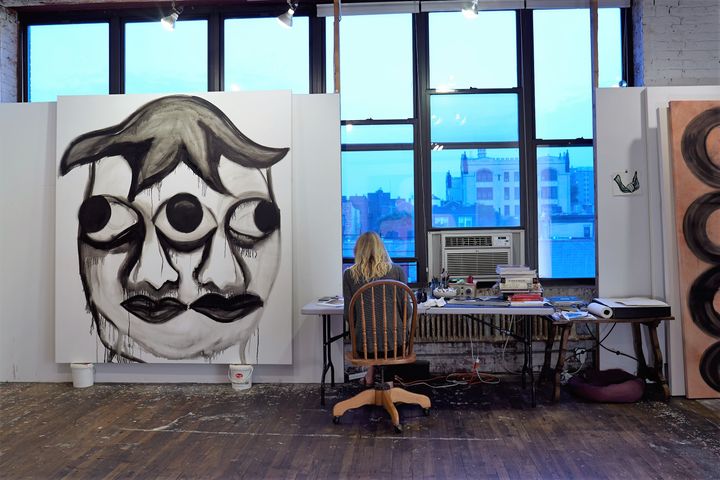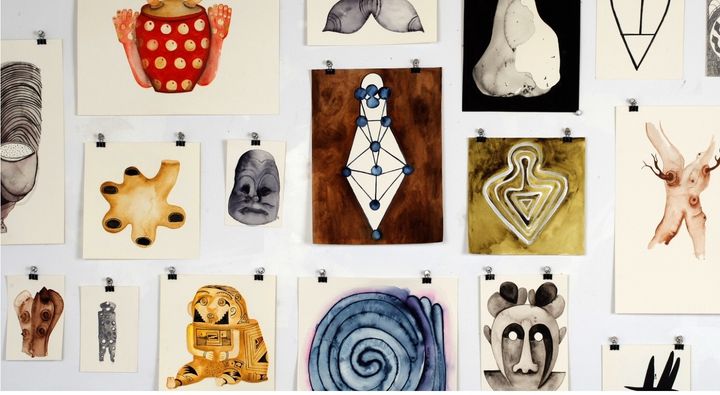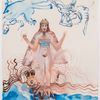
Syrian Eye Goddess, 2015,
Oil on canvas, 90 x 80 inches,
Courtesy of the Artist
Elizabeth Insogna: Your paintings intersect the ancient world in ways that evoke a personal connection indicative of a meaningful resurgence. Could you talk about this relationship?
Becky Kinder: I have been working from ancient objects for the past three years or so. I started by being interested in very old American cultures, things that used to be called Pre-Columbian, but over time this has grown to include all kinds of things, from all kinds of times and places and made for all kinds of reasons.
A few years ago my mom was diagnosed with a degenerative brain disorder and she has been losing her facilities since. Over the intense process of taking care of her I became interested in how we change and die and what we leave behind. Where have the parts of her that are no longer there gone? Discovering artifacts from a gone culture is like finding the collective memories or dreams of the people who made them.
The objects that have been protected and survive from these ancient cultures are about the most important, fertile, traumatic and powerful things: life, birth, death, sex, love, survival, the divine. Seeing these objects is like intimately meeting their makers, even though our cultures could be thousands of years apart, across the globe and infinitely different. These objects reach through all of that difference and that is what I connect with. It’s like being drawn to another person, sometimes you don’t initially know why, but the feeling and the reasons behind it can be very profound.
I am working through my own life emotions through these images, trying to understand my self and my connection to the world, as we all are. I’m less interested in what these objects mean in an anthropological sense than in how they resonate now, how they help me to comprehend my own experience of taking care of my dying mother, falling in love, being triumphant, making mistakes, falling out of love, failing, not being sure and trying to connect with myself truthfully. I consider the paintings a visual diary.
EI: Your work oscillates between intimate & delicate works on paper, to large bolder works that are completed quickly. Could you talk about these processes as well as the raw & spiritual qualities that are a part of your work?
BK: The small works are a way of getting to know the material I am working with. The drawings are done directly from an image or from life, at a museum. Through the act of drawing it, the object is translated through me and becomes a part of my vocabulary. I work to understand it while it is working its way through me, effecting and changing me. The knowledge that I gain through doing this lets me be freer, more expressionistic and vulnerable in the large paintings. The images in the paintings are more inventive, intuitive and uninhibited and are a union of several objects or ideas of objects.
The paintings are large and very physical, related to my body. Sometimes I am painting an object that is a couple inches high on a canvas that is taller than I am. I try to just let the paintings happen and not clean them up more than necessary to make them legible. The paint runs and pools, is wiped away and re-applied. The sensibility and speed of drawing is there as is the action and movement of my body while I am making the work.
At my studio, you described my paintings as hungry ghosts, and I really identified with this. Searching, uneasy, unsettled, restless. Images with unfinished business in this world and maybe even leaning towards the unfinished themselves.
EI: How does your daily Ashtanga Yoga practice influence your work?
BK: Great question, I hope I can do it some justice. Ashtanga is an intensely disciplined physical and devotional practice and it’s how I start most of my days. One of the things the practice is about is giving in, paying attention and being true to yourself, in that moment. If you try to do anything else, the truth will out itself, you will be injured or exhausted or bored and out of whack and you will have to adjust back and surrender to your true ability. I think painting is the same, sometimes you think you are working with certain ideas and then the real content of the work makes itself known slowly over time. Having the attention to recognize that is a huge part of sustaining an interesting and alive practice of painting over a lifetime. We change, our imagery changes, meaning changes for us. We don’t always have to control this or know why these changes are happening. There’s freedom and possibility in that not knowing.
Ashtanga forces you to be honest and humble and that’s invaluable to making art, trusting and just letting yourself go. I see a lot of work that is a celebration or flaunting of people’s symptoms, and that can be fascinating, comforting and extremely relatable. There is so much pain. Ashtanga and painting are both ways of sorting through that. What if we were thriving, mentally healthy beings? What would our work be about then?
EI: What have you been reading lately?
BK: I’m a voracious reader. I have a couple ongoing reading projects. One is reading books and essays about love. Another is reading the journals, letters and autobiographies of women artists, writers and intellectuals. And I love epic, long novels, so I love both the Ferrante and the Knausgaard that everyone is reading now. Both can be seen as coded diaristic projects.
The best book that I have read about love so far is The Art of Loving by Erich Fromm. It’s a very Buddhist book, even though he was a Frankfurt School psychoanalyst, and I love that he came to these ideas about love being something that has to extend to everyone and everything in order for it to be genuinely felt for one other person. He talks about love as a state of being, not an attachment to an idea or person. It’s huge, liberating and really beautiful. Struggling to understand love is one of the things that is at the center of my practice, and this book was a revelation for me. It seems so simple, and yet…
I have slowly been reading the letters of Georgia O’Keeffe and visited her home in New Mexico last year. Along with Frida Kahlo’s home and Lee Krasner’s studio, it is one of the few preserved sites where a woman artist lived and worked and it is a powerful place. By the end of the tour I was openly weeping. I identify with her solitude and admire her courage to do what was necessary to make her work. She is often trivialized, but she was a strong fore bearer of a truly American abstraction. So much of what we know, admire and do wouldn’t have been possible without her.
A few months ago I joined a feminist reading group, we call ourselves In(queery), and that has been so valuable for really looking at what it is and has been to be a woman, a feminist and a creative person. There’s a power in looking closely at that history and understanding it and it has been amazing to do this with a group of people of different ages, experiences and responses. These issues are so present, as both a wall that I come upon daily and as a pure delight and source of meaning in my life and work.

Becky Kinder was born in Nebraska, raised in Texas, and works in New York. She has an MFA from Hunter College and has done residencies at Skowhegan and The Wassaic Project. Her work has been included in group shows at Tracy Williams Ltd. and Regina Rex, and will be in the show False Deities curated by Jim Butler at Gridspace this fall.

Totem Pole, 2015,
Oil on canvas, 80 x 72 inches,
Courtesy of the Artist

Courtesy of the Artist
Elizabeth Insogna is a painter in Brooklyn.
